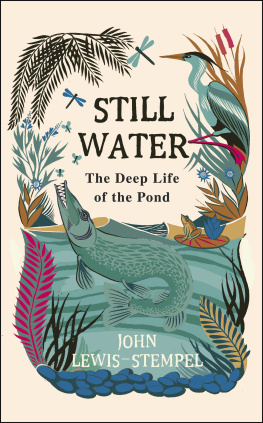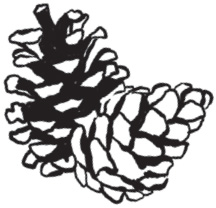Contents
TRANSWORLD PUBLISHERS
6163 Uxbridge Road, London W5 5SA
www.penguin.co.uk
Transworld is part of the Penguin Random House group of companies whose addresses can be found at global.penguinrandomhouse.com
First published in Great Britain in 2017 by Doubleday
an imprint of Transworld Publishers
Copyright John Lewis-Stempel 2017
Cover design andillustrations by Beci Kelly/TW
John Lewis-Stempel has asserted his right under the Copyright, Designs and Patents Act 1988 to be identified as the author of this work.
Illustrations by Beci Kelly
Every effort has been made to obtain the necessary permissions with reference to copyright material, both illustrative and quoted. We apologize for any omissions in this respect and will be pleased to make the appropriate acknowledgements in any future edition.
A CIP catalogue record for this book is available from the British Library.
Version 1.0 Epub ISBN 9781473542518
ISBN 9780857524560
This ebook is copyright material and must not be copied, reproduced, transferred, distributed, leased, licensed or publicly performed or used in any way except as specifically permitted in writing by the publishers, as allowed under the terms and conditions under which it was purchased or as strictly permitted by applicable copyright law. Any unauthorized distribution or use of this text may be a direct infringement of the authors and publishers rights and those responsible may be liable in law accordingly.
1 3 5 7 9 10 8 6 4 2
C ONTENTS
A BOUT THE A UTHOR
John Lewis-Stempel is a writer and farmer. His previous books include The Wild Life: A Year of Living on Wild Food, Meadowland: The Private Life of an English Field, which won the 2015 Wainwright Prize, The Running Hare: The Secret Life of Farmland, which was shortlisted for the 2017 Wainwright Prize, and Where Poppies Blow, which won the prize. John writes for Country Life and won the BMSE Columnist of the Year Award in 2016. He lives on the borders of England and Wales with his wife and two children.
A BOUT THE B OOK
Dusk is filling the valley. It is the time of the gloaming, the owl-light. Out in the wood, the resident tawny has started calling,
Hoo-hoo-hoo-h-o-o-o.
There is something about owls.They feature in every major culturefrom the Stone Age onwards. They arecreatures of the night, and thus of magic.They are the birds of ill tidings, avianmessengers from the Other Side. Butowls with the sapient flatness of theirfaces, their big, round eyes, their paternalexpressions are also reassuringly familiar.We see them as wise, like Athenas owl,and loyal, like Harry Potters Hedwig.Human-like, in other words.
No other species has so captivated us.
In The Secret Life of the Owl,John Lewis-Stempel explores thelegends and history of the owl.And in vivid, lyrical prose, hecelebrates this magnificent creature,whose natural powers are asfantastic as any myth.
The Owls
Among the black yews, their shelter,
the owls are ranged in a row,
like alien deities, the glow
of their red eyes pierces. They ponder.
They perch there without moving,
till that melancholy moment
when quenching the falling sun,
the shadows are growing.
Their stance teaches the wise
to fear, in this world of ours,
all tumult, and all movement:
Mankind drunk on brief shadows
always incurs a punishment
for his longing to stir, and go.
Charles Baudelaire (182167),
translated by A. S. Kline
P ROLOGUE
The Owl in the Wood
THE TAWNY OWL in Three Acre Wood sometimes glides over my head as he takes an evening circuit. (The animals, like us, have their rituals.) There are times when he comes within three feet two even? and I cannot tell, so quiet is his flight except for a slight weightiness in the air around me. This is at twilight, so when I look up, I see his stub of shadow in the sky. At night when he passes overhead he is subtext, something present but unseen.
We farm pigs, sheep and cattle to the edge of the wood (and sometimes in it), so Old Brown and I are well acquainted. I go about my business, he about his. To be accepted by an owl you must be a familiar in the scene. Owls are fearful of the new.
Old Brown likes to sit on an ornamental, twist-barked chestnut tree just inside the wood. I walked up to him last week, in evenings fire-glow, and he observed my approach with professorial focus. Birds know intention. So I kept my hands in my coat pockets, to prove the pax. I suppose he let me approach to within ten feet, until he flew off on his slow, moth wings; the lord of the night. There was no alarm. He had simply lost interest, and had better things to do than spend time human-watching.
I, on the other hand, had no greater want than to go owl-watching.
I NTRODUCTION
O is for Owl
HOWL .
The word owl goes back to the ule of Anglo-Saxon times, and has equivalents across Europe (French hibou, German Eule, Dutch uil, Latin ulula), all of them derived from some root-word used by the Ancients to denote and imitate the cry of the wolf. Like the howling wolf, the howling owl is a creature of the night, thus of magic.
Night is when evil deeds are done. Accordingly, no witchs potion has ever been complete without a portion of owl (in Shakespeares Macbeth, Act IV, the witches famously want a wing of howlet), no Gothic novel finished without an owls ghostly hooting, no horror flick ended without a big close-up of an owls staring eyes. Even such a consummate twentieth-century literary technician as Sylvia Plath was unable to resist a dab of pale, raptorial owl in her poetry to suggest the menace possessing a New England town.
Night is desolation, and so is the habitat the owl makes its resort. The prophet Isaiah foresaw the overthrow of Babylon, after which, amid the wasteland, owls shall dwell there. Owls belong to ruins, woods and moors. Truly, they are wild birds.
Owls carry out their lives when we, diurnal beings, are asleep. Nocturnality is as rare in birds as it is in humans; less than 3 per cent of avians work after sunset.
Owls, then, are Other. They are beyond the pale of light, civilization, goodness. When the medieval English needed a neologism for the crime of the midnight smuggling of wool fleeces to France, what did they invent? Owling.























